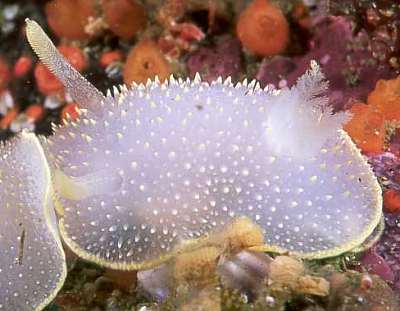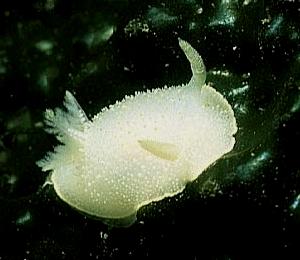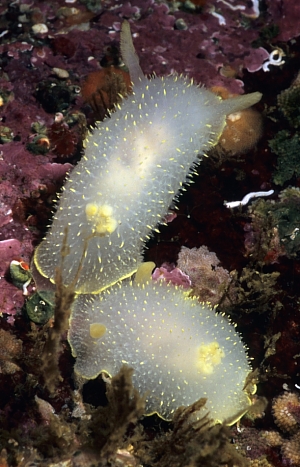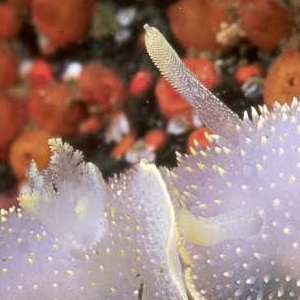

Acanthodoris hudsoni
MacFarland, 1905
Order: NUDIBRANCHIA
Suborder: DORIDINA
Superfamily: ANADORIDOIDEA
Family: Onchidorididae
PHOTO
Upper: Northern end of Vancouver Island the first week of October diving around Port Hardy and Browning Pass, British Columbia, Canada. October 2003. Photo: Bruce Wight.
Lower: Vancouver, Canada. divesite "Flemming Bay", August 12, 1997. Size about 3 cm, Depth 12 m. Photo: Frank Gloystein. Apparently this is a photo of a pale colour form in which yellow markings are a pale cream.
The body and mantle are translucent white. The mantle is covered with long pointed papillae. The rhinophores have a relatively short stalk and a long recurved lamellate club. Both the gills and rhinophores are translucent clear but the tips of the gills and rhinophore club are suffused with a yellow tinge. There is an opaque border to the mantle which is usually a milky yellow. The tips of the papillae are usually of the same colour. In some specimens the mantle border and tips of the papillae are cream white rather than yellow.
Reference:
• MacFarland, F.M. (1905). A preliminary account of the Dorididae of the Monterey Bay, California. Proceedings of the Biological Society of Washington, 18: 35-54
Rudman, W.B., 2000 (October 29) Acanthodoris hudsoni MacFarland, 1905. [In] Sea Slug Forum. Australian Museum, Sydney. Available from http://www.seaslugforum.net/find/acanhuds
Related messages
First record of feeding by Acanthodoris hudsoni
April 15, 2010
From: J. Goddard, J. Hildering & G. Miller

Concerning message #21137:
Hi Bill,
After looking at additional, higher resolution images of the prey organism of Acanthodoris hudsoni pictured in message #21137, we have determined it to be the ctenostome bryozoan Alcyonidium, not a compound ascidian as Dave previously stated. In the photo with the A. hudsoni egg mass one can clearly see the extended lophophores of the bryozoan, as well as some feeding scars left by the dorid. A feeding scar is also visible in the upper image. The opaque spots in the bryozoan are its ova or developing embryos.
Locality: Bear Cove, 75 feet, British Columbia, Canada, northeast Pacific Ocean, 27 October 2007, rock shelf. Length: 4 cm. Photographer: Jackie Hildering.
This food record, the first known for A. hudsoni, is consistent with the diets of four other species of Acanthodoris from the northeastern Pacific Ocean, all of which are now known to prey on Alcyonidium (summarized by McDonald, 2007). As discussed by Soule et al. (2007), species of Alcyonidium from the northeast Pacific Ocean all require taxonomic revision, so we currently do not know if different species of Acanthodoris are specializing on different species of Alcyonidium or not.
- McDonald, G. R. 2007. Sacoglossa and Nudibranchia. Pp. 788-807 In: J. T. Carlton (ed.) The Light and Smith manual: intertidal invertebrates from central California to Oregon. University of California Press, Berkeley.
- Soule, D. F., Soule, J. D., Morris, P. A., and Chaney, H. W. 2007. Bryozoa. Pp. 866-904 In: J. T. Carlton (ed.) The Light and Smith manual: intertidal invertebrates from central California to Oregon. University of California Press, Berkeley.
Best wishes,
Jeff, Jackie, and Glen
goddard@lifesci.ucsb.edu



Dear Jeff, Jackie, and Glen,
I note that in an earlier message [#10690] I suggested it would most probably be found to feed on a bryozoan. Your find is certainly another valuable addition to our knowledge.
Best wishes,
Bill Rudman
Feeding of Acanthodoris hudsoni
August 1, 2008
From: Jackie Hildering & Glen Miller

Here are some photos showing the feeding behaviour of Acanthodoris hudsoni. These images better show the grazing of two animals on what I think is orange finger sponge (Neoesperiopsis rigida ).
Locality: Bear Cove, 75', British Columbia, Canada, Pacific Ocean, 27 October 2007, Rock shelf. Length: 4 cm . Photographer: Jackie Hildering.
Jackie Hildering & Glen Miller
earthlingenterprises@telus.net
Hildering, J. & Miller, G., 2008 (Aug 1) Feeding of Acanthodoris hudsoni. [Message in] Sea Slug Forum. Australian Museum, Sydney. Available from http://www.seaslugforum.net/find/21137
Dear Jackie and Glen,
We appreciate this submission greatly, as there are no references in the literature concerning the food of this species.
That said, species of Acanthodoris do not feed on sponges, only tunicates. The yellow brown prey in your photos is a compound tunicate, not a sponge. Note the zooids. I wish I could ID it but I cannot find it in any of my references. This is great information.
Thanks,
Dave Behrens
Acanthodoris hudsoni from British Columbia
February 20, 2007
From: Marli Wakeling

Here are a pair of trailing Acanthodoris hudsoni, found near Port Hardy, British Columbia.
Locality: Northwest Passage, 45 feet, British Columbia, Canada, Pacific, 30 August 2006, Rock wall. Length: 15 mm. Photographer: Marli Wakeling.
Cheers,
Marli
scubamarli@gmail.com
Wakeling, Marli, 2007 (Feb 20) Acanthodoris hudsoni from British Columbia. [Message in] Sea Slug Forum. Australian Museum, Sydney. Available from http://www.seaslugforum.net/find/19493Thanks Marli,
Best wishes,
Bill Rudman
Acanthodoris hudsoni from British Columbia
October 23, 2003
From: Bruce Wight


Dear Bill
Here are some photos of Acanthodoris hudsoni from our recent trip to British Columbia.
Johanna and I were up at the Northern end of Vancouver Island the first week of October diving around Port Hardy and Browning Pass, British Columbia. This was our first time diving in Canada.
We also found Acanthodoris nanaimoensis
Take care,
Bruce Wight
bwproductions@earthlink.net
Wight, B., 2003 (Oct 23) Acanthodoris hudsoni from British Columbia. [Message in] Sea Slug Forum. Australian Museum, Sydney. Available from http://www.seaslugforum.net/find/11281
Thanks Bruce,
I've included a close-up here showing the rhinophore of one animal and the gills of another/ Your photos show the milky yellow colour very well
Best wishes
Bill Rudman
Food of Acanthodoris hudsoni
August 8, 2003
From: Hawk
I'm doing a project on opisthobranchs and i couldn't find what Acanthodoris hudsoni eats anywhere in books or on the internet. If you could help I would be very happy.
thnx,
Hawk
info@projecthawk.com
Hawk, 2003 (Aug 8) Food of Acanthodoris hudsoni. [Message in] Sea Slug Forum. Australian Museum, Sydney. Available from http://www.seaslugforum.net/find/10690Dear Hawk,
As far as I know we don't know what this species feeds on. However we can get a good idea by looking at what its close relatives eat. Other species of Acanthodoris all feed on bryozoans, so we can be fairly sure that that is what Acanthodoris hudsoni feeds on as well. This is one of the reasons it is best to use scientific names for animals, as you have done, because the first word in a scientific name [the genus name] gives us information on a species relatives. For example, Acanthodoris hudsoni is closely related to all the other species in the genus Acanthodoris. If we want to predict its biology and ecology the best place to start is to look at other species of Acanthodoris. If we only used 'common' names it might be called 'Hudson's nudibranch' or the 'Furry dorid' and so we would have no easy way to relate it to other nudibranchs.
Good luck with your project,
Bill Rudman
Acanthodoris hudsoni from California
June 6, 2003
From: Clinton Bauder

Hi Bill,
Jim Lyle's photo matches the typical color of the animals of Acanthodoris hudsoni I see here in Monterey [California]. Here is another picture (details of size and depth lost over time...)
I'm pretty sure this is Acanthodoris hudsoni based on the 5 branchial plumes and very long rhinophores.
Clinton
gecko1@apple.com
Bauder, C., 2003 (Jun 6) Acanthodoris hudsoni from California. [Message in] Sea Slug Forum. Australian Museum, Sydney. Available from http://www.seaslugforum.net/find/10164Thanks Clinton,
I thought I should get some local knowledge as the photo in Dave Behren's book shows a distinctly yellow border and papillae tips, while the photos on the Forum show only the slightest hint of yellow.
Best wishes
Bill Rudman
Acanthodoris hudsoni? from California
June 5, 2003
From: Jim Lyle

I'm a newbie to this site. Hopefully, when I send this, the picture will be attached. I'll keep my fingers crossed.
I have tentatively identified this dorid as Acanthodoris hudsoni based on comparison to pictures in Dave Behrens' book and on this web site.
It was found on the wreck of the Avalon, off Palos Verdes Point, California in 78 feet of water.
Jim Lyle
jlyle@beachnet.com
Lyle, J., 2003 (Jun 5) Acanthodoris hudsoni? from California. [Message in] Sea Slug Forum. Australian Museum, Sydney. Available from http://www.seaslugforum.net/find/10120Dear Jim,
Welcome to the Forum. Acanthodoris hudsoni is described as having yellow tips to the papillae and a yellow mantle border. I guess this animal is a variation without the yellow but I would be grateful for some comments from local experts as the only other photo I have on the Forum of this species also lacks the yellow.
Best wishes
Bill Rudman
Acanthodoris hudsoni from British Columbia
October 31, 2000
From: Jeff Goddard
Hi Bill,
Erwin Koehler's dorid (29 October message) looks like Acanthodoris hudsoni to me. The color pattern, long rhinophores, and long slender dorsal papillae all fit. Acanthodoris nanaimoensis is similar in shape but has relatively shorter, red-tipped rhinophores and red-tipped branchial plumes. Cadlina luteomarginata is similar in color to A. hudsoni but has shorter rhinophores and low dorsal tubercles.
Best wishes,
Jeff
goddard@lifesci.ucsb.edu
Goddard, J., 2000 (Oct 31) Acanthodoris hudsoni from British Columbia. [Message in] Sea Slug Forum. Australian Museum, Sydney. Available from http://www.seaslugforum.net/find/3258Thanks Jeff,
Bill Rudman.
Re: Acanthodoris hudsoni
October 31, 2000
From: Marli Wakeling
Although the photo looks pale compared to photos in Dave Behren's Pacific Coast Nudibranchs, I commonly find these with pale colouration. The only other similar nudibranch that is all white is Acanthodoris pilosa, but it's papillae are a bit heavier looking. He does note that the rhinophores of A. pilosa bend backwards when extended, like in the photo. The gills, though look like A. hudsoni. Hopefully Sandra Millen will pinpoint this one.
Marli Wakeling
scubamarli@excite.com
Wakeling, M., 2000 (Oct 31) Re: Acanthodoris hudsoni. [Message in] Sea Slug Forum. Australian Museum, Sydney. Available from http://www.seaslugforum.net/find/3259Thanks Marli,
Bill Rudman.
Is this Acanthodoris hudsoni from Canada
October 29, 2000
From: Erwin Koehler

Dear Bill,
This one is from Canada, Vancouver, divesite "Flemming Bay", August 12, 1997, size about 3 cm and depth 12 m. I think it is Acanthodoris hudsoni MacFarland, 1905
It was taken by Frank Gloystein. His email address is: frank@gloystein.de
Erwin
Medslugs.Koehler@t-online.de
Koehler, E., 2000 (Oct 29) Is this Acanthodoris hudsoni from Canada. [Message in] Sea Slug Forum. Australian Museum, Sydney. Available from http://www.seaslugforum.net/find/3244Dear Erwin,
Certainly looks like it could be A. hudsoni but it is described as haiving yellow tipped, gills, rhinophores and papillae and a yellow band around the mantle edge. I guess it depends whether the colour is not showing up very well in Frank's photo. Let's see what the experts think.
Best wishes,
Bill Rudman.
